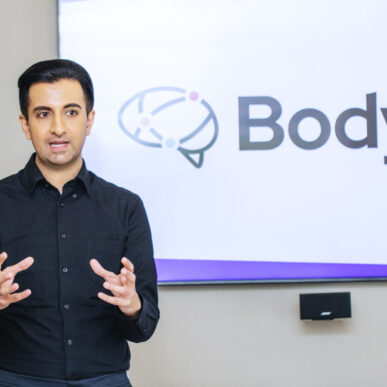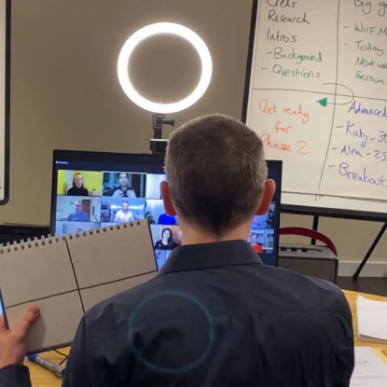On the train to London a few months ago, I heard a small group of business colleagues discussing the big pitch they were about to deliver in a few hours. There was lots of chat about who was saying what, who would be there and any last changes to the slide deck. The main focus of the conversation, though, was how everyone felt. From the seat behind, I got the sense that although they all sounded highly qualified, well-prepared and knowledgeable, they all had large amounts of self-doubt.
As the train ambled through Vauxhall on the approach to Waterloo, they were all offering supportive thoughts to each other about why they were the best person for the job, why they shouldn’t be worried and how they were going to ‘nail’ it, yet that air of anxiety still lingered.
This scenario may sound familiar to many of us. It is not uncommon to experience a fear of presenting in both our professional and personal lives. These can manifest in different ways, such as feeling self-conscious, anxious, or simply lacking confidence.
In the case of the business colleagues on the train, their self-doubt was a clear indication of potential mental blocks. As much as I would have liked to share my experience in dealing with these types of situations, I didn’t want to intrude on their conversation. That would have been weird and unhelpful! However, as someone who has overcome mental blocks and self-doubt when presenting to millions of people on live TV and having coached thousands of clients through similar challenges, I can offer some tips that may help you before you get on the train.
Recognising the Mental Blocks
The first step to overcome mental blocks is acknowledging their existence, and fear is perhaps one of the biggest ones. Fear of judgment, fear of failure, fear of not being good enough.
Clinical Psychologist Zachary Sikora from Northwestern Medicine says that fear is a core survival response. While it originates in the mind, its effects extend throughout the body. Recognising fear prompts the amygdala to act (the amygdala plays a crucial role in processing emotions, especially those related to fear and pleasure. It helps to trigger the body’s response to perceived threats and acts as an emotional alarm system, influencing our reactions and behaviours in response to various stimuli) signalling the nervous system and releasing stress hormones like cortisol and adrenaline. This physiological sequence results in increased blood pressure, elevated heart rate, faster breathing, and a redistribution of blood flow to the limbs. Essentially, the body readies itself for the age-old fight-or-flight response. Dr Sikora also says that when the amygdala senses fear, the cerebral cortex, which deals with reasoning and judgement, gets cloudy, and it becomes much harder to be rational or make clear decisions.
Using Stoicism to Conquer Fear
While the business colleagues on the train were attempting to drown their self-doubt in waves of positivity, there’s an alternative approach rooted in stoicism. Stoicism teaches us to accept what is beyond our control and focus on our responses. In the context of presenting, this means acknowledging that nerves and self-doubt may arise but choosing not to be controlled by them.
Instead of trying to eliminate fear, stoicism encourages us to understand it. Fear is a natural human response, and rather than viewing it as a weakness, it can be seen as a signal that we care about the outcome. Here are a few suggestions to use stoicism to embrace fear and reframe it so it can be a source of strength rather than a hindrance.
Control Your Responses, Not the Outcome
Stoicism emphasises the importance of focusing on what we can control. Instead of fixating on the outcome of the pitch, redirect your attention to the aspects you can manage – the preparation, delivery, and mindset. It’s also helpful to acknowledge that we cannot control how every member of the audience will respond or whether they will buy into our ideas. However, we do have agency over how we respond and how we can best present our ideas.
Embrace Vulnerability with Strength
Stoicism doesn’t advocate for suppressing emotions but rather for embracing them with resilience. By accepting that self-doubt might be present but choosing to proceed regardless, you can exhibit courage in the face of uncertainty. The pursuit of success involves stepping out of our comfort zone. It’s natural to feel uncomfortable when doing something new, but this discomfort should not be seen as a negative sign. Stoicism teaches us to embrace discomfort as an opportunity for growth and learning.
Accept the Possibility of Failure
In his book “The Antidote,” Oliver Burkeman emphasises a profound insight: failure is an inescapable facet of life, and embracing it is key to navigating the complexities of our journeys. Burkeman encourages readers to accept failure as an integral part of the human experience rather than viewing it as a setback. By acknowledging failure as a natural occurrence, we open ourselves to valuable lessons, resilience, and growth. Stoicism teaches us to accept the possibility of failure without allowing it to paralyse us. It can be a liberating feeling to acknowledge that not every presentation will be flawless.
Know your audience
Enough about ourselves. Knowing your audience can play a significant role in mitigating mental blocks and boosting confidence. When you understand your audience’s background, expectations, and potential concerns, it helps to build trust and rapport. When you’ve got that, the atmosphere in the room changes from ‘impress me’ to ‘I’m on your side’. This empathic approach allows you to anticipate questions, concerns, or objections, providing a strong mental framework that contributes to a more assured and composed presentation.
Anecdotal evidence often highlights instances where speakers who take the time to understand their audience create a more relaxed and engaging atmosphere. By incorporating relatable examples or tailoring anecdotes to match the audience’s experiences, speakers can establish a connection that goes beyond the formalities of a presentation. This personal touch not only humanises the speaker but also creates an environment where mental blocks are less likely to take hold. Simply put, we tend to like people who are like us.
Anticipate rather than improvise
We’ve talked plenty about emotions and mindset, but there are some practical and logical steps to overcoming mental blocks too. Notes are good, but keep them to short bullet points either on your presenter notes on your slide deck or on a piece of paper on the desk in front of you. Holding your notes can make you seem uncertain and often lead to limited eye contact.
Learning scripts is bad news. If you’ve ever learned a script verbatim and then lost your thread, you’ll know that feeling of panic that overwhelms you when you’re trying to remember what comes next. Instead, focus on outlining key themes or talking points and allowing room for spontaneity. This approach not only takes the pressure off of memorisation but also promotes a conversational tone, making the presentation more relatable and engaging.
How to answer questions
Preparing for questions is a prudent practice, but overthinking them can become a mental stumbling block. While anticipating potential queries is essential, it’s equally crucial not to overthink every conceivable question. Striking the right balance involves a strategic approach – identifying the most probable questions and preparing thoughtful responses, steering clear of a meticulous examination that could contribute to pre-presentation jitters. You could also adopt an approach from the world of Executive Coaching where we don’t answer questions but question answers. Or, to put it another way, be more curious when someone asks you something. Dig in a little and make sure you fully understand the question; it will also give you a bit more thinking time!
Tell a story
Finally, never underestimate the power of storytelling. If you ever watch Dragon’s Den, the entrepreneurs who generally get the investment tell the best story. They’ll talk of a challenge or pain that people face and the better future that can be achieved by using their product or idea. Daniel Kahneman explains this idea of ‘loss aversion theory’ in his book Thinking Fast and Slow. Loss aversion is a cognitive bias that describes why, for individuals, the pain of losing is psychologically twice as powerful as the pleasure of gaining. If you can start to tap into this simple human instinct, then you’ll get the attention of the audience, and if I had to prescribe a cure to overcome mental blocks and presentation anxiety, it would be a room of nodding heads.
From personal coaching to storytelling and peak performance mindset workshops, we have a number of ways we can help you overcome mental blocks. Please feel free to get in touch to discuss the next steps for you.


















